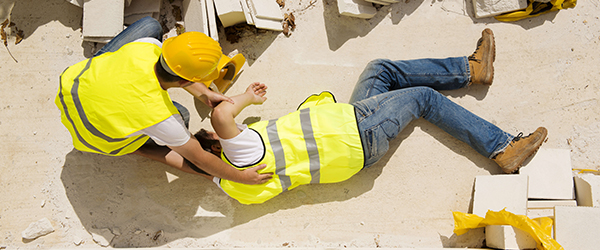Hazardous falls currently account for a third of fatalities at construction sites. Also the leading cause of death in the building industry, a fatal fall can shut down projects and create detrimental liabilities for businesses big and small.
Fortunately, reducing the risk of falls is an entirely attainable goal, as most deaths and injuries are recorded as preventable. In this article, we provide a variety tips for reducing the risk of falls at not only construction sites, but a wide range of businesses. You can utilize these regulations to make your small business office, shop, or home environment safe as well.
Take Time to Identify Potential Hazards
The first step is to prevent potential hazards is to analyze the conditions of your construction site. Before starting a job, complete a thorough walkthrough of your work zone and consider its potential surface risks. Be especially attentive to elevated surfaces and off-ground work areas; OSHA requires the implementation of stairs for steps 19 or more inches off of the ground.
Even if you are familiar with workplace safety regulations, never downplay the benefits of connecting with a safety expert. They may be able to identify dangers that you missed, and zero-incident days can save you from losing valuable work time.
When working in an unpredictable climate, or following hazardous weather conditions, make sure that your sites surfaces are clear of leaves, mud, ice, snow, and even water. Leaving loose tools and equipment lying around is exceptionally hazardous. You can address the risks of surface clutter and debris by promoting an organized work environment and modifying wet/muddy ground conditions with a layer of dry gravel to help absorb water.
Provide the Proper training
Wherever there is a “human” element, there is a risk. You need to make sure your workers are adequately trained in safety procedures, which means more than merely keeping surfaces clean. Guidelines should be comprehensive, and workers should be educated and practiced before operating foreign machines or using hazardous tools alone.
Safety rules, procedures, and guidelines must consistently be enforced and reiterated. No matter an employees level of experience or task at hand, skirting around rules is unacceptable and dangerous.
Safely access work areas
Make areas and tools physically accessible. Obviously, this will be more difficult in high environments than sites at ground level, but by utilizing platforms, aerial lifts, and safety ladders your workers won’t strictly “move” by stretching.
Make Sure Everyone Knows How To Use Safety Equipment
Safety equipment, such as harnesses, are a necessity, and every employee must know how to use them properly. Workers must also be able to identify when their equipment is subpar or damaged.
Insufficient safety equipment and improper material usage can create a false sense of safety, and therefore increase the risk of injury and on-site accidents.
Follow Regulations “To a T”
OSHA safety regulations are a great start, but by no means the minimum precautions you should enforce. Aim to not only promote but practice regulatory strategies at your work site. From head protection, to hazard communication, to ladder and scaffolding regulations, OSHA created guidelines to reduce accidents, and enforcing the basics to a T will help your employees develop automatic, cautious tendencies.
Load-bearing guidelines must be strictly implemented at every construction site and small business facility, and the appropriate coverings, warnings, and fall arrest systems must surround any holes or skylights.
Use Safety Systems Designed For Heights
Saftey techniques can prevent injuries from slips or trips, and, in worst case scenario, an extreme fall. Off ground accidents account for the majority of fatal injuries and deaths in the construction industry but can be prevented with the appropriate safety gear and precautions.
There are a variety of safety systems designed specifically for heights, which by implementing you can turn a would-be fall into a task completed with ease. Pulleys, harnesses, braking systems, the specific system you use depends on the construction site and situation.
Develop and Practice Your Emergency Protocols for Falls
Like fire drills in grade school, everyone on your construction site should be informed and practiced of emergency protocol. Has a pulley and/or harness system broken? Has someone fallen and been injured? Is someone suspended from their safety harness? Is a major storm threatening your construction site?
While anything can happen, try to cover all of your bases, and reinforce a standard procedure for possible hazards. Your employees should know when and how to call emergency services. They should know which construction site managers to report to first as well. This means not only having protocols in place but making sure everyone has practiced them.
Conclusion: Falls Can Be Serious But You Can Reduce Risks
While the suggestions above offer a great start to risk-proofing your job sites and employees, having an on-premise employee well versed in safety protocol can help reinforce and attend to such regulations when everyone else is focused on the job at hand. Extra preparation can save workers from injuries and businesses from liabilities. There are enough variables to a construction site, and having a plan around construction site safety will greatly assist in the consistency of your jobs, and help bolster your bottom line.






